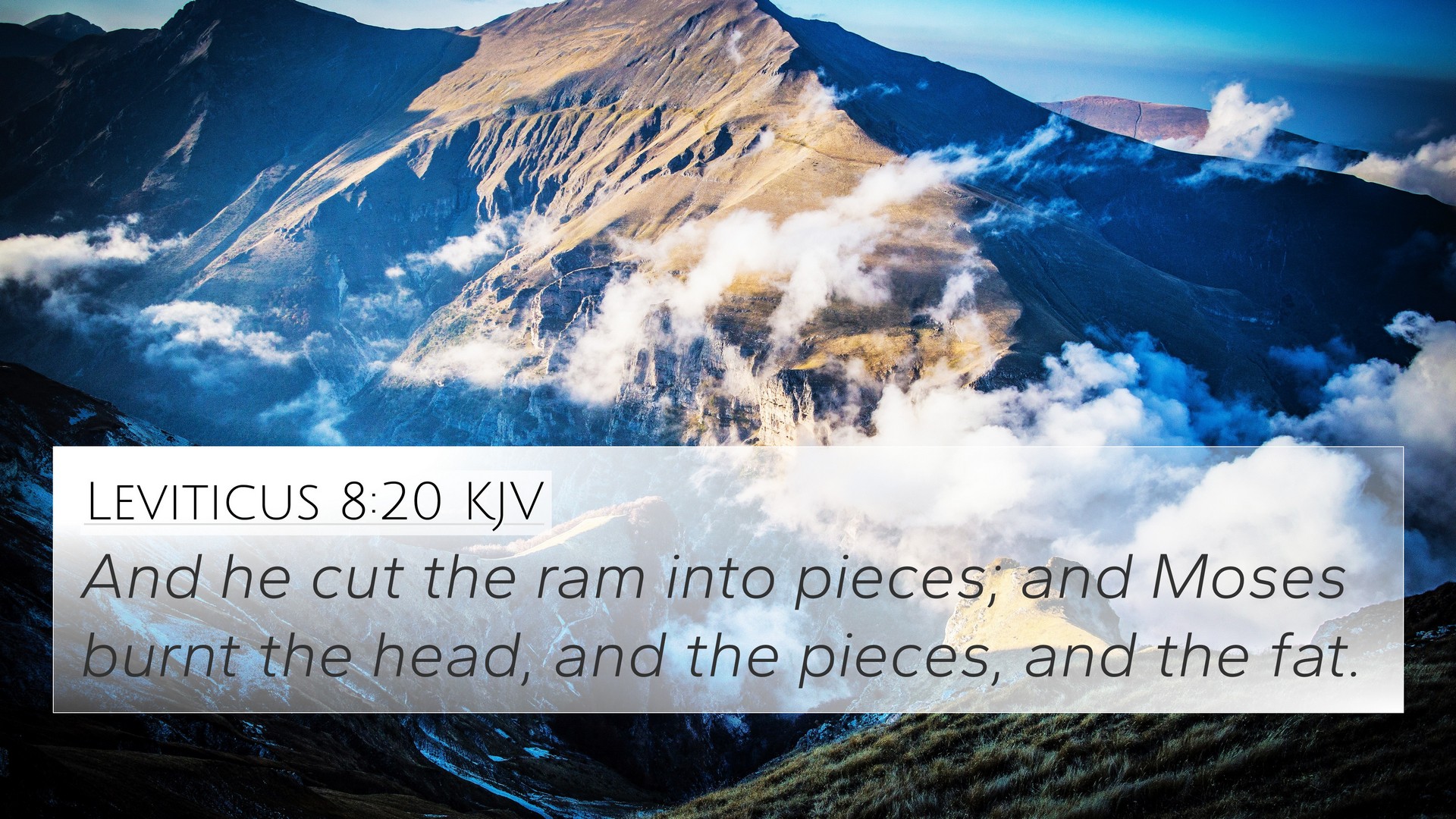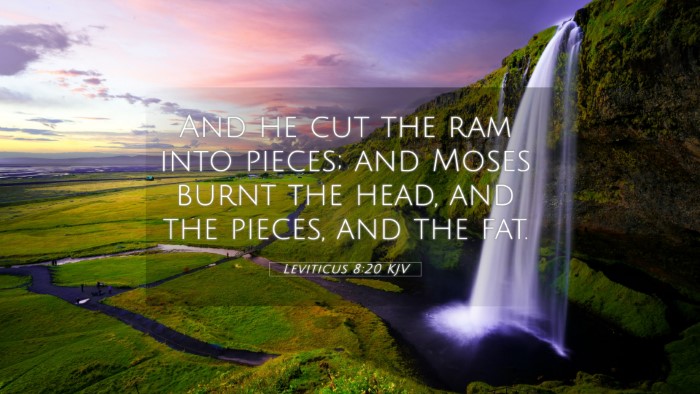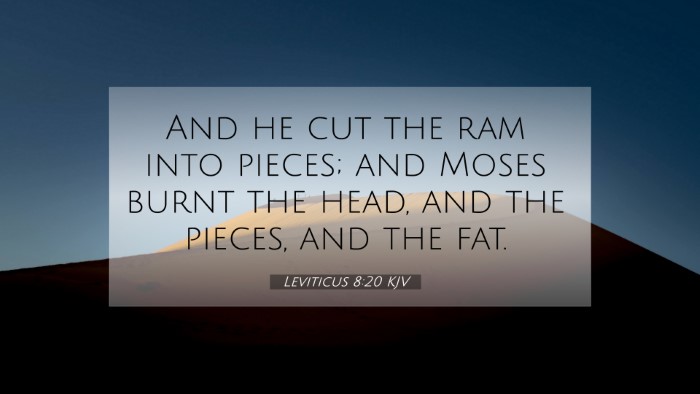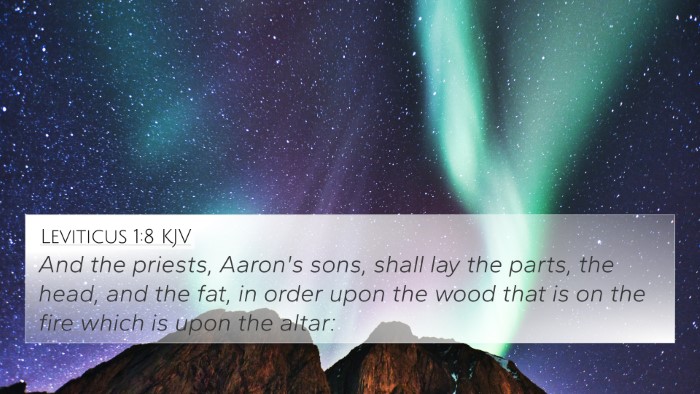Meaning and Interpretation of Leviticus 8:20
Leviticus 8:20 states:
“And he took the second ram, the ram of consecration; and Aaron and his sons laid their hands upon the head of the ram.”
Overview
This verse describes a significant moment in the consecration of Aaron and his sons as priests. The laying on of hands is a symbolic act demonstrating the transfer of responsibility and authority, serving as a vital ritual within the framework of Old Testament worship.
Commentary Insights
Insights from renowned public domain commentaries provide a layered understanding of this passage:
-
Matthew Henry:
Henry emphasizes the importance of consecration, focusing on how the laying on of hands designates the recipients as set apart for sacred duties. He draws connections between this act and the broader themes of sacrificial worship in the Jewish tradition.
-
Albert Barnes:
Barnes elaborates on the symbolism of the ram and its role in the ordination process. He interprets the ram as a representation of Christ, the ultimate High Priest, whose sacrifice fulfills the requirements of the Old Covenant.
-
Adam Clarke:
Clarke points out the ancient practices of consecration, linking them to later New Testament contexts. He discusses how this ritual prefigures the ministry of Jesus and the significance of priesthood in the New Covenant.
Significance of the Act
The act of laying hands on the ram serves multiple purposes:
- Identification: The priests identify with the ram, symbolizing their acceptance of the responsibilities of the priesthood.
- Symbolic Transfer: It signifies the transfer of sin and responsibility, which is a recurrent theme in sacrificial practices.
- Dedication: The ram represents total commitment to God, affirming their duty to serve Him faithfully.
Cross-References with Leviticus 8:20
Understanding this verse gains depth when considered alongside other scriptures. Here are key Bible verses that relate to Leviticus 8:20:
- Exodus 29:10-14: Describes the consecration of the priests and the sacrifices involved.
- Leviticus 4:15: Discusses the role of the elders of the congregation in laying hands on the sacrificial animal.
- Leviticus 16:21: The scapegoat ritual where the priest lays hands on the goat transferring the sins of the people.
- 1 Peter 2:9: Highlights believers as a royal priesthood, paralleling the consecration seen in Leviticus.
- Hebrews 7:11-28: Discusses Christ as a priest in the order of Melchizedek, connecting old rituals to the New Covenant.
- Isaiah 53:6: Connects to the theme of laying sins on a substitute, fulfilled in Christ’s sacrifice.
- Romans 12:1: Calls believers to present themselves as living sacrifices, echoing the themes of consecration.
Thematic Connections Across the Bible
The themes of sacrifice, priesthood, and consecration link this verse with several key Biblical themes
- Priesthood: The establishment of Aaron’s lineage as priests sets the groundwork for understanding priestly functions in both Testaments.
- Sacrifice: The ongoing theme of sacrifice throughout the Bible culminates in the ultimate sacrifice of Christ, the Lamb of God.
- Holiness: The necessity of purity and separation in worship underscores the serious nature of coming before God.
- Divine Calling: The calling and setting apart of individuals for God's work resonates throughout scripture.
Tools for Deepening Understanding
To engage in deeper study and exploration of Biblical texts, several tools and methods can aid in understanding:
- Bible Concordance: A tool to locate specific verses and their references throughout the Bible.
- Cross-Reference Bible Study: This method encourages the exploration of related verses to uncover deeper meanings.
- Bible Reference Resources: Utilize resources that list and explain connections between various verses.
Inter-Biblical Dialogue
Leviticus 8:20 serves as an important link in the dialogue between the Old and New Testaments. It frames the understanding of themes such as:
-
Transition from Old to New:
The practices outlined in Leviticus foreshadow the greater fulfillment through the life and ministry of Jesus Christ.
-
Understanding of Sacrifice:
This passage and the rituals within it predate and define the context for New Testament teachings on sacrifice and atonement.
Conclusion
In conclusion, Leviticus 8:20 is not merely a historical account; it is rich with theological implications that resonate through the entirety of Scripture. The act of consecration, through the laying on of hands, establishes a framework for understanding priesthood, sacrifice, and the holiness required to approach God. By employing tools for cross-referencing, one can discover the extensive connections and themes that interweave throughout the Bible, revealing a cohesive story of redemption and divine relationship.



